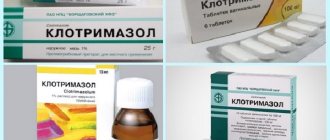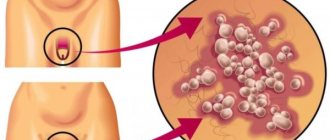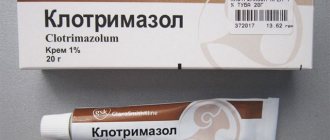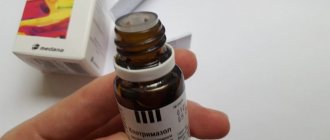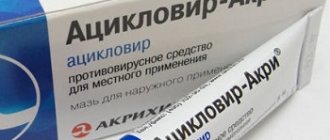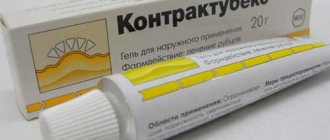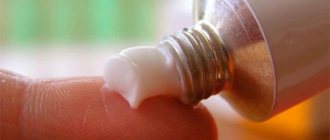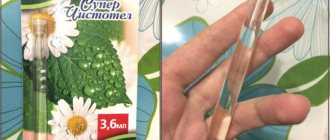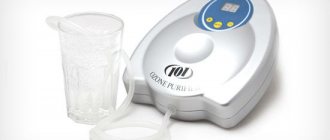Properties and composition
The active component of the drug destroys the cell plate of fungal spores. Clotrimazole extracts potassium, phosphorus compounds and biological polymer molecules from the fungal cell. The drug increases the intracellular level of hydrogen peroxide, as a result of which pathogenic microorganisms die. In addition to destroying pathogenic cells, this agent suppresses the process of their further reproduction.
The drug contains the active component clotrimazole. Additional substances: monoglycerides E471, emulsion wax, oil solvent, food additive E1520, stearyl and cetearyl alcohol, glycerin, castor oil, preservatives E218 and E216, distilled water.
Pharmacodynamics and pharmacokinetics
Clotrimazole inhibits the growth and reproduction of microorganisms, has a fungistatic effect and leads to the death of fungi. Due to inhibition of ergosterol synthesis, the component combines with phospholipids of the fungal cell membrane, changing its permeability. In high concentrations, clotrimazole damages fungal cells by lysis without suppressing the synthesis of ergosterol, prevents the formation of proteins, fats and polysaccharides of fungi, destroys their nucleic acids and increases the excretion of potassium.
The drug acts on dermatophytes, yeasts, dimorphic and mold fungi, protozoa, plus destroys gram-positive bacteria. Fungistatic activity is manifested against the mycelium of dermatophytes, budding fungi from the genus Candida.
When applied topically, the drug is absorbed by the epidermis. The highest concentration of the substance is determined in the reticuloderm. It is also able to penetrate the keratin of nails.
Clotrimazole enters the systemic circulation in very small quantities and is metabolized in the liver to inactive substances that are excreted from the body through the excretory system.
What is it used for in adults: instructions for use
The drug is actively used to combat fungal diseases and various skin rashes. Depending on the diagnosis and severity, Clotrimazole is prescribed in one form or another.
Antifungal agent
Before using the drug, thoroughly rinse and dry the affected area. Then apply a thin layer of ointment and rub in with massage movements. Using a solution instead of an ointment, 2-3 drops of the product will be enough for an area equal to the size of the palm.
After using Clotrimazole, you must wash your hands with soap (if the ointment was not specifically applied to your hands) to avoid further spread of the fungus throughout the body. Also, after each water procedure, you should wipe dry the areas damaged by the fungus.
For thrush, it is recommended to use tablets or drops in the vagina once a day and apply ointment to the perineum twice a day. For prevention purposes, it is recommended that the woman’s sexual partner also undergo treatment.
During the treatment of fungus, a specially designed towel must be used for damaged areas of the body.
Cream for external use on the face
Before starting therapy, it is necessary to establish the root cause of the rash. Clotrimazole in the form of a cream is used to treat:
- acne;
- age spots;
- mycosis;
- dermatitis.
Facial acne is often caused by staphylococcus or streptococcus bacteria. Clotrimazole, in turn, effectively reduces the level of activity of pathogenic microflora. The first positive results will become noticeable after 3 days.
Clotrimazole is also prescribed to combat age spots. Using the product for 3-4 weeks, dark spots on the skin will become noticeably lighter, and in combination with the right care cosmetics, an improvement in the condition of the facial skin will not take long.
The cause of rashes on the face may be mycosis. The disease manifests itself as a result of the activity of parasitic fungi. Treatment of this disease involves the use of Clotrimazole, but for greater effectiveness it must be used in combination with antibiotics and other antifungal drugs. The cream is also prescribed for dermatitis of various origins.
Clotrimazole (Clotrimazolum): a synthetic broad-spectrum antifungal agent
Author: Andrey Anatolyevich Dotsenko
Last modified: 2020-08-5 Date written: 2016-12-16
The effectiveness of Clotrimazole has been tested by time. For several decades, since 1969, it has been used for the local treatment of fungal infections affecting the skin and mucous membranes
Clotrimazole
Active substance
The active substance of the same name, Clotrimazole, belongs to the class of azoles, their variety, imidazole derivatives.
The chemical name of Clotrimazole is 1-[(2-Chlorophenyl)diphenylmethyl]-1H-imidazole.
Formula – C12H17ClN2. It is a white crystalline powder that is odorless.
Practically insoluble in water, but soluble in ethyl alcohol and other organic solvents - ether, chloroform, propylene glycol.
Formula Clotrimazole C12H17ClN2
Mechanism of action
The action of Clotrimazole, like other imidazole derivatives, is based on the inhibition of enzymes of the Cytochrome P 450 system, which is involved in the synthesis of ergosterol, the main component of the fungal cell membrane.
Inhibition of Cytochrome P 450 automatically leads to disruption of ergosterol synthesis. As a result, the permeability of the cell increases and it dies. These largely determine the fungicidal effect of Clotrimazole - its ability to destroy pathogenic (disease-causing) fungi.
Ergosterol is not only a component of the cell membrane, but also a kind of hormone that ensures cell division and growth. Inhibition of its synthesis is accompanied by a fungistatic effect - slowing down the growth of the fungus.
Clotrimazole has a dose-dependent effect on pathogenic fungi, in small quantities it is fungistatic, in large quantities it is fungicidal. In this case, only the fungus-specific enzyme Cytochrome P450 is inhibited. The drug has no effect on similar enzymes in humans and mammals.
However, the fungistatic and fungicidal effect of Clotrimazole is not limited to inhibition of ergosterol synthesis alone. It blocks calcium channels, and thereby prevents the intracellular penetration of calcium. This leads to calcium depletion in fungal cells.
It also affects the state of other cellular organelles - it causes the destruction of lysosomes and reduces the number of ribosomes. Clotrimazole also inhibits other enzymes - peroxidases, which leads to cell death from excess hydrogen peroxide.
Due to disruption of ergosterol synthesis, its precursors, 14 L-methylsterols, accumulate, which also cause the death of the fungal cell.
The drug is deprived of the ability to be absorbed into the blood from the gastrointestinal tract (gastrointestinal tract). Therefore, it is only suitable for external use.
Recently, evidence has emerged that in vitro (in vitro, literally in a test tube), the drug inhibits the growth of atypically altered tumor cells. Its ability to inhibit peroxidase can be used in the fight against malaria pathogens, and blockade of calcium channels can be used in the treatment of sickle cell anemia.
Receiving mechanism
The starting material for the production of Clotrimazole is a benzene derivative, 2-chloro-toluene. Then, through successive chemical reactions involving a series of organic catalysts, the finished product, Clotrimazole, is obtained.
In the production of dosage forms, along with the main substance, auxiliary substances are also used. These are alcohols, sorbitan stearate, lactose monohydrate, magnesium colloidal silicon dioxide, potato starch, adipic acid, and other organic and mineral compounds.
Clotrimazole Indications
Indications
The drug is effective against many fungi that parasitize the skin - dermatophytes (genus Epidermophyton, Trichophyton, Microsporum), as well as yeast fungi of the genus Candida.
Other types of yeast-like and mold fungi are also sensitive to Clotrimazole, including Actinomycetes, Histoplasma, Cryptococcus, Blastomycetes, Malassezia, Aspergillus, and many others.
In addition, it is effective against certain types of bacteria. These are mainly gram-positive flora - staphylococci and streptococci, and to a lesser extent - corynebacteria.
Clotrimazole also has a detrimental effect on some gram-negative microorganisms - bacteroides, gardnerella vaginalis, as well as on some types of protozoa - Trichomonas vaginalis and amoebas that parasitize the gastrointestinal tract.
The scope of application of Clotrimazole includes:
- Dermatomycoses - athlete's foot, trichophytosis, microsporia
- Versicolor (pityriasis versicolor)
- Mycoses of the feet with damage to the periungual fold (fungal paronychia), nail plates (onychomycosis), interdigital spaces
- Oral candidiasis (candidal stomatitis)
- Thrush in women (candidal vulvovaginitis) and in men (candidal balanoposthitis)
- Other mycoses of the skin and mucous membranes caused by yeast-like and mold fungal flora
- Mycoses complicated by secondary bacterial infection - pyoderma, streptoderma
- Erythrasma is a pseudofungal disease affecting large folds of skin caused by corynebacteria.
- Trichomoniasis.
Clotrimazole is used not only for therapeutic purposes, but also for preventive purposes. It is prescribed to women during a course of antibiotic treatment to prevent thrush, as well as before childbirth to sanitize the birth canal.
Release forms
The drug is available in various dosage forms for external use:
- 1% cream, ointment and gel
- 1% spray and solution for external use
- Vaginal suppositories 100 and 200 mg
- Vaginal tablets 100, 200 and 500 mg
- 2% vaginal cream.
The drug is produced by many Russian and foreign pharmaceutical companies under the name of the active substance, or under numerous original names.
In Russia, along with domestic Clotrimazole, Indian drugs are common - Candide, Canihol, Funginal, Imidil.
The world-famous Glaxo Smith Klein also produces a drug called the active substance. Another, no less well-known company, Hexal, produces Antifungol, and Bayer's medicines, depending on the country of origin, are called Canesten, Gyno-Canesten, Empicid.
Despite the fact that these drugs act in the same way (the active ingredient is the same), their cost varies widely. The big name of the manufacturer, more careful adherence to technology, import and advertising costs have an effect.
Clotrimazole Applications
Application
Before applying the drug, wash the corresponding area of skin with warm water and dry with a clean cloth. Cream, gel, or ointment is rubbed in a thin layer 2-3 times a day.
A strip 5 mm long, squeezed out of the tube, is enough to treat the skin with an area of the palm of your hand. The duration of treatment depends on the location and type of mycosis. For foot mycoses this is approximately 2 weeks, for pityriasis versicolor - 1-3 weeks, for other skin mycoses - up to 4 weeks.
The spray is sprayed evenly, and the solution is gently rubbed in in similar dosages. For onychomycosis and oral candidiasis, the solution is more preferable because, unlike cream and ointment, it has greater penetrating ability.
The oral cavity is treated 3 times a day with a cotton swab soaked in solution. After treatment, you should refrain from eating for 1 hour. Duration of treatment – no more than 1 week.
If there is concomitant damage to the external auditory canal, place a cotton swab 4 times a day for 5-10 minutes. Duration of treatment – 1 month. The solution is also used to treat fungal urethritis - the external opening of the urethra is treated and injected into the urethra 2 times a day for 1 week.
For fungal infections of the vagina, 100 mg of the drug in the form of suppositories or tablets is administered intravaginally once during the day, at night. The optimal body position for deeper penetration is lying on your back with your legs apart.
To facilitate the absorption of tablets, they are moistened in boiled warm water before use. The course of treatment is about 6 days, if necessary it is repeated, but so as to be completed before the next menstruation. During the entire treatment period, you should refrain from douching.
During the treatment of trichomoniasis, Clotrimazole is combined with Metronidazole. For vulvovaginitis, along with tablets, ointment or cream is used, which is used to treat the corresponding areas 2-3 times a day for 1-2 weeks. The same applies to men with fungal balanoposthitis.
In men, longer treatment with the drug may be required for 2 weeks. after the disappearance of clinical symptoms. It is important that in case of fungal infections of the genitals, antifungal therapy is carried out synchronously for both partners.
For preventive purposes, 1 tablet is administered once before giving birth to women. 200 mg. When treating skin and mucous membranes, Clotrimazole should not be applied to areas with wounds and abrasions. Contact with eyes is also undesirable. After applying the drug, do not apply sealed bandages to the skin.
Pharmacodynamics
Being a drug for external use, Clotrimazole is practically not absorbed into the blood and does not have a systemic effect. When applied to the skin and nail plates, it quickly penetrates into the deep layers, where a minimum fungus-inhibiting concentration is created.
When administered intravaginally, 3 to 10% of the drug is absorbed. In this case, it is metabolized in the liver under the action of microsomal enzymes and excreted in the feces.
Side effects
Develops in places where Clotrimazole is applied:
- Skin and oral mucosa: irritation with redness, swelling, burning, blistering and peeling.
- Genital mucosa : redness, itching, burning, swelling of the vulvar mucosa, pathological vaginal discharge, burning and itching of the glans penis, cystitis with frequent urination, dyspaurenia (painful sexual intercourse).
These side effects occur rarely and do not require discontinuation of the drug.
Clotrimazole Contraindications
Contraindications
- Individual intolerance to the drug
- Age up to 6 years.
For vaginal tablets and suppositories:
- Menstruation at time of use
- Menstrual irregularities
- Pain in the lower abdomen of unknown cause
- Uterine bleeding
- Violations of the integrity of the vaginal mucosa with the presence of erosions and ulcerations
- Pathological discharge with an unpleasant odor
- Any other conditions accompanied by irritation, redness and swelling of the vaginal mucosa
- Fever and chills.
Pregnancy and lactation
It is impossible to exclude a negative effect of the drug during the formation of fetal organs and systems. Therefore, Clotrimazole is contraindicated in the first trimester of pregnancy.
It can be used only in the II-III trimester, and even then only in extreme cases, when the expected benefit outweighs the risk of possible negative consequences.
There is no evidence that Clotrimazole passes into breast milk. However, during lactation it is also prescribed according to strict indications and with great caution.
Interaction with other drugs
- Polyene antibiotics (Neomycin, Natamycin, Amphotericin B) – a mutual decrease in the activity of these drugs and Clotrimazole.
- Corticosteroids (Dexamethasone, Prednisolone, Hydrocortisone) – inhibition of the activity of Clotrimazole.
Storage
The drug is stored at a temperature of 15-250C for 3 years. Dispensed with a doctor's prescription.
Is it possible for children
Clotrimazole can be used for children strictly with the permission of a doctor. In some cases, in addition to this drug, other antifungal medications are prescribed.
Up to a year
Thrush often occurs on the skin and in the mouth of infants. Clotrimazole ointment and solution are used to treat it. For candidiasis of the skin with increased dryness, ointment is most often used, applying it 2-3 times a day, in a thin layer on a pre-washed (with fragrance-free soap) and dried area. The duration of treatment is at least 2 weeks.
For thrush in the mouth, it is recommended to apply a 1% solution twice a day. For one procedure, a few drops of the drug are enough to treat damaged areas. If positive changes are noticeable after 5-7 days, treatment should be extended to 2 weeks. Otherwise, exclude Clotrimazole.
After a year
Children are often diagnosed with a skin disease such as ringworm, which is transmitted through contact with animals or people with this disease.
Ringworm is characterized by the appearance of red spots on the skin that are itchy and flaky. If microsporia occurs on a non-hairy part of the body, Clotrimazole ointment is prescribed. It should be used up to three times a day, on previously washed areas of the skin. Treatment can last 28-40 days.
In case of lichen in areas covered with hair, Clotrimazole is used in the form of a solution in combination with antifungal drugs for oral administration. For foot sweating accompanied by erosive formations, treatment includes the use of Clotrimazole and powder.
Effect on fungus
Clotrimazole has fungicidal and fungistatic effects. The first means the complete destruction of the fungus due to damage to their membrane membranes, which become permeable, as a result of which the microorganism dies. The second property can be observed when using small doses of the drug - the spread of the drug stops, the transition to healthy areas of the mycosis focus does not occur, but the fungus is not completely destroyed - only the process of its reproduction slows down or stops.
Clotrimazole also has other beneficial properties, which makes getting rid of the fungus faster. The drug relieves most of the unpleasant symptoms of mycosis, including itching, pain, dry skin, cracks, ulcers, and erosions. Thanks to this, the protective properties of the dermis are restored, and it becomes an unfavorable environment for the development of fungus.
Price and analogues
The pricing policy of the drug also varies depending on the manufacturer and form of release.
The average price for a pack of tablets is 30 rubles. Products for external use are sold in pharmacies at prices ranging from 50 to 220 rubles. The most expensive is the cream. The price of the solution is approximately 230 rubles.
Analogues of Clotrimazole:
- Kanizon cream for external use with an identical active substance.
- Mycozon. The composition includes the substance miconazole with a dosage of 2%. Used to treat ringworm.
- Kanesten. The active ingredient is identical. Prescribed for the treatment of lichen and other fungal diseases.
- Candide. The cream is used to combat thrush, nail fungus and dermatophytosis.
- Bifosin. Used in the treatment of candidiasis, microsporia, mycosis of the feet and hands.
What does Clotrimazole help with?
For external use of clotrimazole, the following indications are distinguished:
- nail fungus (onychomycosis, fungal paronychia),
- trichophytosis,
- dermatophytosis,
- fungal erosion and diaper rash,
- candidomycosis,
- microsporia,
- athlete's foot,
- dermatomycosis complicated by secondary pyoderma of mycoses.
Indications for the use of the lotion include infectious diseases, pathogens that are resistant to nystatin and a number of other antifungal agents.
The drug is not suitable for the treatment of pityriasis rosea, since this disease most likely has a viral or infectious-allergic origin, and may also be the body’s response to a severe shock or nervous breakdown. Clotrimazole is effective against fungal infections.
Precautions when using the drug
When using the medication, you should adhere to the following rules:
Fungal ointment with clotrimazole
- Wash your hands before applying the drug and after applying.
- Store the drug at a temperature of 2 degrees to 25 degrees Celsius.
- Take externally only.
- Keep away from children and pets.
- When using on the face, be careful not to get the substance into your eyes. If this happens, rinse them with clean water. If symptoms of redness, pain, or blurred vision persist, consult a doctor immediately.
- Store the drug in a dark place.
Indications
What vaginal tablets (suppositories) help with:
- vaginal candidiasis (with thrush);
- trichomonas vaginitis.
Read: The best remedies for nail fungus
Used as a preventive measure in gynecology, before the procedure.
Solution, cream, ointment:
- dermatomycosis of smooth parts of the body and feet;
- onychomycosis;
- lichen (pityriasis versicolor, multi-colored, red);
- balanitis;
- erythrasma;
- superficial candidiasis.
It is also used for infection of mucous membranes with fungi that are sensitive to the drug.
Ointment or cream – which is better to choose? There is no exact answer to the question, because the compositions of these forms are practically the same and their indications are the same. But the composition of the ointment is more suitable for people with sensitive skin.
Patient reviews
- Fedor: “My wife’s thrush worsened during pregnancy. The doctor prescribed her clotrimazole suppositories. And he told me to use the cream, rubbing it into the reproductive organ. I didn’t have any symptoms of thrush, but I listened to the doctor. We underwent treatment, and the disease passed safely. During childbirth, the wife was given a one-time sanitation with clotrimazole. The child was born healthy and without problems.”
- Ilya: “Foot fungus haunted me for a long time. I tried different drugs, both expensive and cheap, as well as some folk remedies. But only clotrimazole helped me, which I rubbed into my feet every day at night, and during the day I also lubricated them with cream. The first signs of healing appeared within a couple of days - the redness, itching and unpleasant odor disappeared. I continued treatment for 4 weeks until the disease completely subsided.”
Clotrimazole side effects
As a rule, there are no side effects associated with the use of the drug, but sometimes local irritation in the form of itching or burning, as well as allergic reactions, may occur.
Additional instructions
Do not apply the drug to the skin around the eyes.
If after a month the treatment does not give any positive results, then it should be stopped and examined to clarify the diagnosis.
If an allergic reaction or local irritation develops, treatment should be stopped and replaced with another.
Drug interactions
A high concentration of para-hydroxybenzoic acid propyl ester can enhance the effect of Clotrimazole.
High doses of Dexamethasone can inhibit the effect of Clotrimazole.
The drug itself is capable of reducing the effect of polyene antibiotics (nystatin, natamycin, amphotericin) when used simultaneously.
Advantages and disadvantages
Suppositories for the treatment of candidiasis
This medicine is very popular as it has many advantages. The most important of them:
- A large number of dosage forms.
- Allergic reactions are rare.
- Can be used in pregnant women from the 12th week of pregnancy.
- Easy to apply and quickly absorbed.
- Price.
- Prevalence - the drug is always available in the pharmacy.
The disadvantages, of which there are not many, include possible side effects, as well as existing contraindications.
Special instructions and expert advice
With a significant spread of fungal infection, the patient may experience intoxication of the entire body, the manifestation of allergic reactions, as well as inflammatory processes in various organs and tissues. The addition of a bacterial infection makes the situation much worse. That is why treatment should begin as early as possible - at the first signs of the disease.
The doctor does not always send the patient for diagnosis using scraping or another method. Most often, the diagnosis is made after a visual examination - by external signs or by identifying mycelium and single cells of the fungus under a microscope. The strain of the microorganism also does not always need to be determined, because the treatment will be identical. However, a diagnosis is prescribed if after 2 weeks of using clotrimazole the patient does not experience a positive effect. In this case, a scraping should be taken to determine the causative agent of the infection and its resistance to medications.

